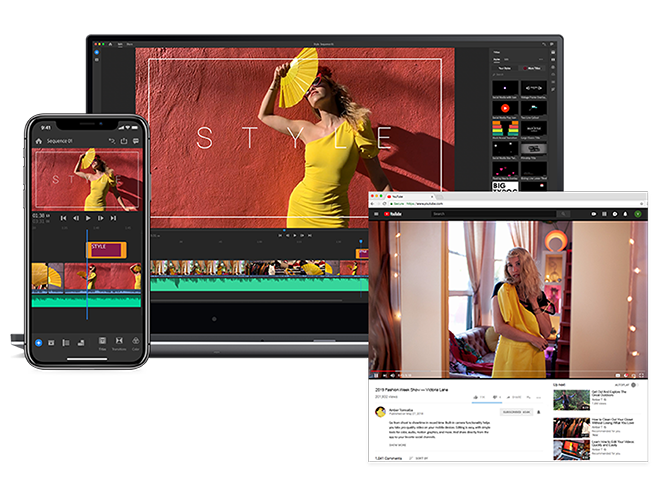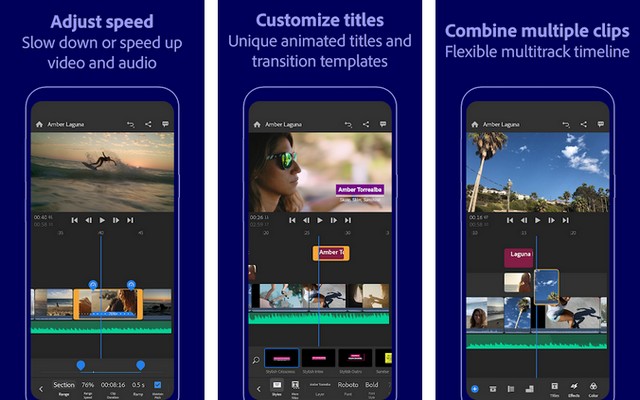

- #Adobe premiere rush app how to
- #Adobe premiere rush app windows 10
- #Adobe premiere rush app android
- #Adobe premiere rush app pro
- #Adobe premiere rush app software
If you're looking for a full-screen experience, just the same as your other Windows apps, you should try installing Android emulators such as LDPlayer, BlueStacks, etc. They offer a wide range of features including giving a rich user experience, faster processing, etc.
#Adobe premiere rush app pro
Still not sure? Check out our Premiere Rush review and our Premiere Pro review, too.Android apps can be used on Windows computers seamlessly using Android emulators. It’s designed for speed and simplicity and is a good choice for creating and sharing social media videos. That said, it is perfect for users who are newcomers to editing or aren’t bothered about having precise control over everything. Premiere Rush, in comparison, is highly lacking in depth. With an in-depth yet intuitive interface and many options for editing color, audio, and effects, it has been and continues to be a favorite of professional editors. If you’re a confident editor and want a high level of control over your creative work, Adobe Premiere Pro is the choice for you. Adobe Premiere Pro vs Premiere Rush: Which should I buy? If you only occasionally edit, it’s more cost-effective to pick up a monthly subscription as and when you need it.
#Adobe premiere rush app software
There’s also a free version of Rush, though this limits you to three video exports.īoth these subscription models do mean that the costs of the software can become quite high over time, and it’s only worth committing to an annual subscription if you know that you’ll be doing a great deal of editing throughout the year.

It’s a much cheaper option, though this is reflected in its significantly reduced functionality. Rush, meanwhile, has a simpler pricing structure of £9.98/$9.99 a month, or £119.21/$119.88 a year. All purchases of Premiere Pro come with Rush included. To avoid this, you can subscribe with no commitment for £25.28/$31.49 a month or pay for a year up front for £238.42/$239.88. If you want to cancel it before a year is out, you’ll have to pay a cancellation fee of 50 per cent of your remaining annual contract. Premiere Pro looks like it costs £19.97/$20.99 a month, but this ties you into an annual plan. Premiere Pro’s pricing structure can be misleading (Image credit: Adobe)īoth Premiere Pro and Premiere Rush operate on a subscription pricing model, and there are a couple of options. Adobe Premiere Pro vs Premiere Rush: Support The ability to export straight to social media platforms such as YouTube or Facebook is also a useful time-saving feature.
#Adobe premiere rush app how to
In terms of ease of use, the simplicity of Rush’s design means that you’ll be able to learn how to use it and edit simple videos quicker than with the more complicated Premiere Pro. The more powerful your graphics card, though, the less likely you are to run into these issues. That’s not a problem with Rush because projects on it tend to be much simpler. That said, Premiere Pro has been known to run slowly or even crash when more complex projects are being edited when you start layering up its more advanced effects, it can become processor-intensive for Pro to render all the required video. If your computer meets the recommended specifications, you should be able to edit with either program without much lag. However, for Premiere Pro, you’ll also need at least 2GB of GPU VRAM, and it’s recommended that you have at least 16GB of RAM if you want to edit HD video.
#Adobe premiere rush app windows 10
Premiere Pro and Premiere Rush both have the same basic system requirements: Windows 10 or macOS v10.14 or later, 8GB of RAM, and 8GB of hard disk space. Premiere Rush’s simple interface makes for smooth performance (Image credit: Kieron Moore) Adobe Premiere Pro vs Premiere Rush: Performance Still, there are tons of things that you can do within it to make quality, fun social media videos, if you’re not too picky about the minute details. The advantage of Rush is that it’s streamlined and simple to pick up. In short, there’s nothing that you can do in Rush that you can’t also do in Pro, while there are many things that you can do in Pro but not Rush. That said, for most quick social media videos, these will be sufficient to get your video looking good. In Rush, you’re limited to a set of preset colour filters and a few sliders, such as exposure, contrast, and highlights. Pro has several colour effects, including the powerful Lumetri Color, which includes RGB curves, separate wheels for shadows, mid-tones, and highlights. Let’s take colour grading features as an example. All clips and effects in Premiere Pro can be keyframed – for example, you can adjust the opacity or positioning of a clip over time with minute precision, while this is not possible in Premiere Rush. Premiere Pro has much more flexibility than Rush. The major differences reveal themselves when you want to go in-depth with manipulating parts of your edit. Premiere Pro’s depth of features enables precise editing (Image credit: Kieron Moore)


 0 kommentar(er)
0 kommentar(er)
